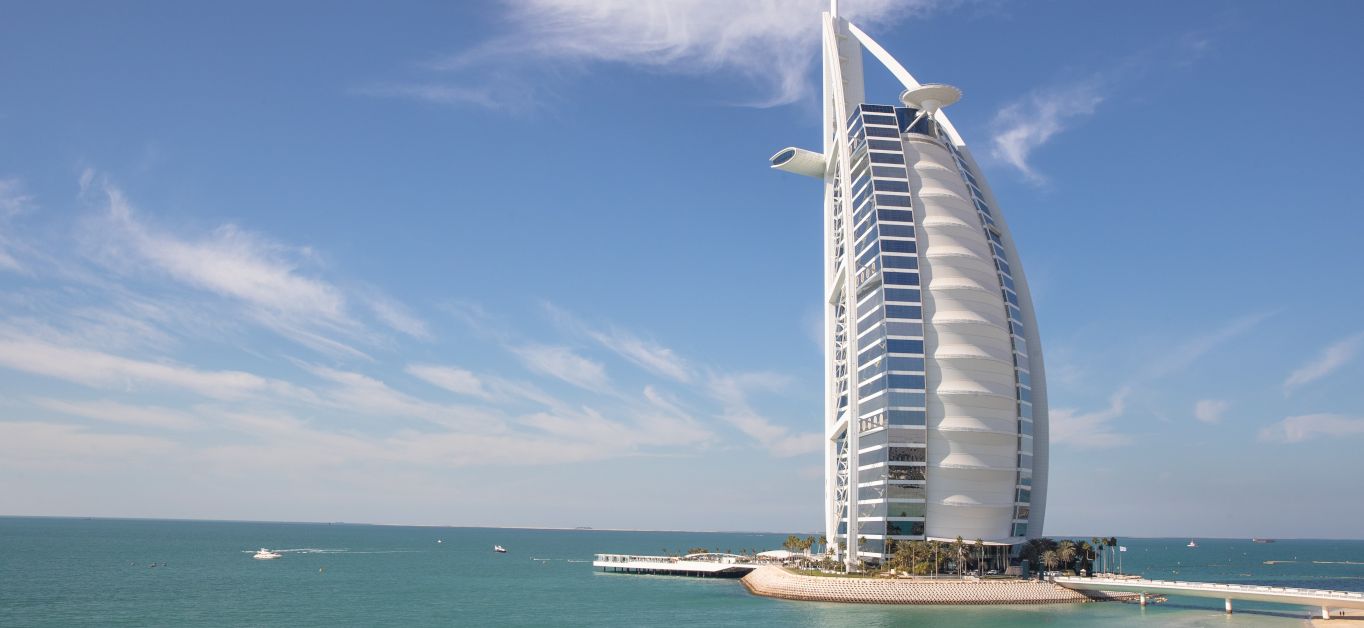Rising from the azure waves of the Arabian Gulf like a sail in the wind, the Burj Al Arab has evolved into among Dubai’s most recognisable icons. Originally opened in 1999, this architectural wonder has been a lighthouse of ambition, luxury, and creativity. Considered among the most opulent hotels ever constructed worldwide, the Burj Al Arab is more than simply a place to stay—it’s a statement of how far Dubai has come in redefining itself on the international travel scene.
Vision Guiding the Icon
Early in the 1990s, while Dubai was getting ready to become a major worldwide tourism destination, the Burj Al Arab narrative starts. Once Crown Prince of Dubai, Sheikh Mohammed bin Rashid Al Maktoum dreamed of a hotel drawing the elite of the globe in addition to serving as a symbol of modernism and development. The intention was to build an international monument on line with the Eiffel Tower in Paris or the Statue of Liberty in New York.
British architect Tom Wright of Atkins was hired to create a building that would immediately come to represent Dubai, therefore realizing this ambition. His answer is a 321-meter tall construction fashioned like the sail of a dhow, a classic Arabian ship. Setting a new benchmark for both architecture and luxury, the distinctive design combined cultural value with future aspiration.
Engineering the Unbelievable
Building the Burj Al Arab was no routine work. Built on an artificial island 280 meters off Jumeirah Beach, it is linked to the mainland by a private bridge. Engineers had to initially build the island by pushing 230 concrete piles forty meters into the ground. Also constructed to guard the island from erosion was a layer of protective concrete honeycomb.
The difficulties did not end here. The unique sail form of the structure demanded engineering answers never tried in a hotel of this size. Computed in five years and costing more than $1 billion, the outcome was a wonder of design and construction that matched its aspirational scale.
Read Also: The Pros and Cons of Living in Al Khail Gate: A Local Guide for Expats and Newcomers
The Grand Opening and Instant Worldwide Focus
When the Burj Al Arab was opened on December 1, 1999, it soon became news everywhere. Promoted as the first “seven-star hotel in the world,” a name not formally used in the hotel sector but invented by an excited British journalist, it set a new standard for ultra-luxury. It changed the hotel industry such that luxury travel expects not only expected but also necessary excess.
Designed by Khuan Chew of KCA International, the interiors highlighted a lavish mix of gold leaf, rich carpets, and complex mosaics. While the Royal Suite became the height of luxury, complete with revolving beds and a private theater, the atrium, 180 meters tall, immediately inspired wonder.
Changing Dubai’s Travel Industry
Dubai did not yet rank as a luxury travel destination on par with Paris, London, or New York before the Burj Al Arab. That altered quite drastically once the hotel opened. Its launch served as a trigger, drawing ultra-wealthy people, monarchy, and worldwide celebrities. Dubai was thrown on the global scene overnight as a refuge for world-class service, luxury shopping, and magnificence.
With the city shortly opening other high-end attractions including artificial islands like Palm Jumeirah, the Dubai Mall, and the record-breaking Book Burj Khalifa Top Tickets, the Burj Al Arab became the focal point of Dubai’s expanding tourism plan. Dubai’s non-oil economy grew mostly dependent on tourism, and much of that success may be seen in the influence of one, bold hotel.
Restining Hospitality Guidelines
Burj Al Arab’s offering established a new worldwide benchmark. Guests at staff-to– suit ratio of 8:1 get a degree of care few other hotels can match. Every suite boasts access to a fleet of Rolls-Royce chauffeur cars, private check-in desks, and a butler service.
With choices like Al Mahara, an underwater-themed seafood restaurant, and Al Muntaha, which provides panoramic views of the Gulf from its perch near the top of the building, dining at the hotel is also quite amazing. For guests looking for luxury and confidentiality, these gastronomic encounters along with world-class spa treatments and ultra-private lodging have made the hotel a favorite choice.
An Architectural and Cultural Legacy
One cannot stress the cultural influence of the Burj Al Arab. Often utilized in media and movies to portray not only Dubai but also modern Arab luxury and creativity, it has become among the most photographed buildings in the world. It is a cultural emblem and a worldwide known monument, not only a hotel.
Architecturally, the hotel spurred a flurry of design-forward projects both inside the UAE and outside. Cities vying with Dubai’s attractiveness began to think about how architecture might be a branding tool. In many respects, the Burj Al Arab demonstrated to the world that a structure could be both national emblem and practical hospitality.
Future Evolution and Sustainability
More sustainable ideas have been included into luxury hotels in recent years. Originally constructed during a period when environmental issues were secondary, the Burj Al Arab has worked toward modernizing its waste management and energy consumption.
Its facilities and services are also constantly improved to keep ahead of the very competitive ultra-luxury hotel scene. The Burj Al Arab is expected to change while keeping its position as the gem of the city as Dubai keeps pushing ahead in sectors including eco-tourism and digital innovation.
Final Thought: The Crown Jewel of Dubai’s Skyline
Still a timeless emblem of what is achievable when ambition meets creativity is the Burj al Arab. From its original visionary idea to its current global icon, the hotel has not only redefined luxury hospitality but also been instrumental in changing Dubai’s worldwide reputation. It reminds both residents and visitors that the remarkable is always within reach in Dubai.


